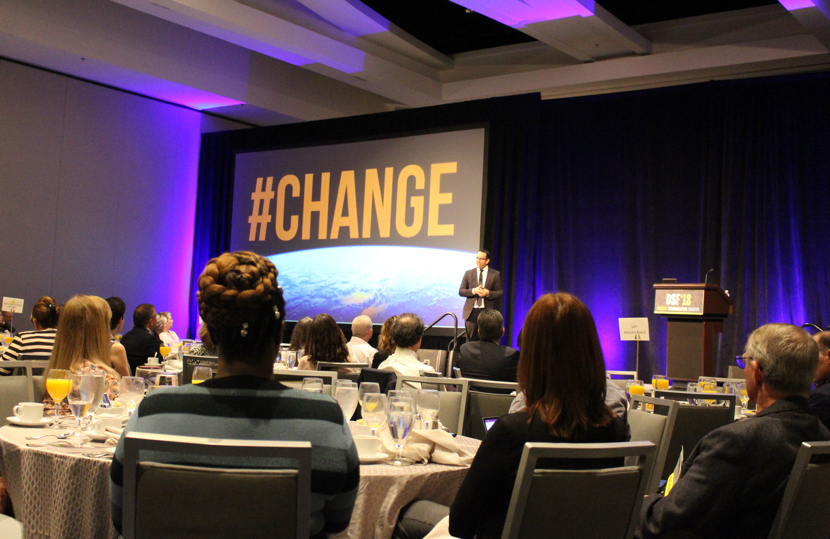
This article appears in the Summer 2018 digital issue of DOCUMENT Strategy. Subscribe.
- Blockchain: This technology will create more change by 2020 than the accounting world has seen in 500 years. Blockchain provides a permanent, immutable way to prove that documents and data are true and accurate. No manipulation of records will be allowed.
- Artificial Intelligence: AI may be the driver for the fifth industrial revolution. Author and Technology Futurist Ian Kahn forecasts that by 2045, the “Point of Singularity” (when computers will exceed the human brain) will arrive. Today, AI is used widely within high-tech services (Facebook, Netflix, and Amazon) and in modern business solutions (IBM’s Watson). Just around the corner, there will be artificial narrow intelligence for repetitive tasks, artificial general intelligence that will be equal to human tasks, and artificial super intelligence when AI will be smarter than humans.
- Cloud: We heard a lot about moving to the cloud. Certainly, the cloud is widely accepted and has many benefits over on-premises solutions

Ian Kahn delivers his keynote at DSF '18, held in Boston this past May, on the #change disrupting the document management industry.
The emergence of AI and robots in the enterprise allows organizations to automate their manual data entry processes, therefore, increasing accuracy, lessening employee fatigue, and enabling predictive analytics—perhaps better than humans. Records will have structure, but the metadata attached to them allows us to retrieve what is needed (even unstructured information) through business processes.
One application for AI is robotic process automation (RPA) to automate repetitive tasks in organizations. At the conference, there was good advice shared by several business users on how to best implement RPA in the real world. During a panel discussion, they provided some best practices to consider for your RPA project:
- Focus on specific repetitive tasks rather than trying to do too much at once.
- Begin with a process that is well understood (such as accounts payable and accounts receivable management).
- Take baby steps when implementing RPA projects to achieve quick wins.
- Start with internal projects, and save customer-facing work for later.
- Stay away from applications that interface with the web, as these are often prone to change.
- Increase customer service, avoid cost, replace full-time employees, and reduce processing time with multi-skill bots and attended or unattended bots.

The DOCUMENT Strategy Forum is an industry peer event for professionals in Customer Communications, Enterprise Content Management, and Information Management dedicated to building superior customer experiences.
The risk of digital migration is that companies lose the chance for regular (low-cost) opportunities to engage with their customers when they attempt to drive them to their portals. Companies need to build the experience around what customers want and then push this data to them. For example, Nancy Green, Assistant Vice President of Customer Communications at MetLife, told fellow conference goers that it’s important to recognize that some documents are more acceptable in digital formats than others. With 146,000 different documents (and mailing 140 million packages per year), the MetLife team spends a lot of time on testing to improve their documents and continually measures their progress with focus groups, surveys, and their Net Promoter Score. Do you?
The third theme we heard a lot about at the DSF was the cloud. According to Bob Dunfee, Vice President at Smart Communications, moving to omni-channel communications can raise your retention rates from 33% to 89%. If true, then omni-channel communications should make every company’s investment short list.
Increasingly, the cloud:
- Facilitates user-friendly communications
- Requires less information technology (IT) resources
- Has zero footprint, requires no hardware, or third-party licenses
- Quicker to implement and can be done in baby steps within the larger framework
Today, the top use cases for cloud are:
- Records management
- Onboarding processes
- General document management
- Linking enterprise content management (ECM) to core systems internally and externally
So, where is the line between AI, bots, and RPA? Perhaps no one knows, but certainly, they are here to stay and will have a greater and greater impact on how we collect, store, and use data. Closing out the conference, Gartner Research Director Karen Hobert left the audience with some eye-opening stats: four percent of companies have deployed AI, 21% are piloting programs or will be shortly, and 25% have plans for the medium term. To drive the point home, 50% of chief information officers say that AI is one of their top five investments.
Companies that implement these technologies with the customer in mind will be the ultimate winners in customer satisfaction, cost reduction, and competitive advantage. See you in Anaheim in 2019!
Companies that implement these technologies with the customer in mind will be the ultimate winners in customer satisfaction, cost reduction, and competitive advantage. See you in Anaheim in 2019!
Richard Rosen is the Chief Executive Officer of The RH Rosen Group. The RH Rosen Group works with clients to reduce costs and improve cash flow through paper reduction and process improvements. Contact him at RichR@RHRosenGroup.com.










